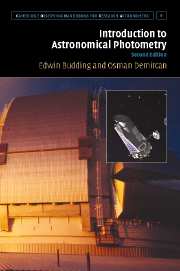Book contents
- Frontmatter
- Contents
- Preface to first edition
- Preface to second edition
- 1 Overview
- 2 Introduction
- 3 Underlying essentials
- 4 Themes of astronomical photometry
- 5 Practicalities
- 6 Procedures
- 7 Basic light curve analysis
- 8 Period changes in variable stars
- 9 Close binary systems
- 10 Spotted stars
- 11 Pulsating stars
- Appendix
- Author index
- Subject index
6 - Procedures
Published online by Cambridge University Press: 13 August 2009
- Frontmatter
- Contents
- Preface to first edition
- Preface to second edition
- 1 Overview
- 2 Introduction
- 3 Underlying essentials
- 4 Themes of astronomical photometry
- 5 Practicalities
- 6 Procedures
- 7 Basic light curve analysis
- 8 Period changes in variable stars
- 9 Close binary systems
- 10 Spotted stars
- 11 Pulsating stars
- Appendix
- Author index
- Subject index
Summary
This chapter is about the essential procedures for setting up and using an astronomical photometric system, and processing its data. The first two sections deal with two basic calibration experiments. There is then a section dealing with observational particulars in the application of a CCD camera. A brief introduction to variable star photometry, including an overview of the timing of photometric phenomena, follows. The treatment and interpretation of data is concentrated on.
The standard stars experiment
The purpose of this is to calibrate a given local photometric system to a standard or reference system, based on detailed comparisons of published magnitude and colour values of standard stars, with corresponding measurements made with local equipment. The experiment is sometimes related to the terms absolute, or all-sky photometry. To do it well normally requires very good, i.e. transparent and stable, sky conditions, but these nights are not so common at most observing locations. They are sometimes described as ‘photometric nights’, though certain kinds of high quality, differential photometry have been carried out (notably with multi-channel or areal photometers) in nights of lesser quality, even where light clouding is present.
The choice and finding of particular standard stars is related to observing experience and particulars of the task. Specialist programmes are underway that continue to produce improved and more extended lists of standards in various photometric systems. But there are also certain well-accepted primaries (Section 3.6), which are normally bright stars and easy to find.
- Type
- Chapter
- Information
- Introduction to Astronomical Photometry , pp. 204 - 246Publisher: Cambridge University PressPrint publication year: 2007



